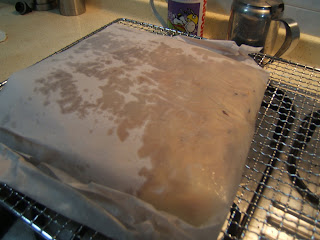in the deep
recently my oven was heated to the highest again. it creates this smell that feels so familiar, because i haven't made hearth breads in a long time.
decided to use hamelman's book again to further develop skills and test the recipes there. this one is focaccia, which starts from a ciabatta dough.

 i wanted onion toppings, so i cooked onions in butter first, like julia child does for her onion soup.
i wanted onion toppings, so i cooked onions in butter first, like julia child does for her onion soup.


 ciabatta dough was very wet and sticky to handle. but since this was going to become focaccia, i used much olive oil to handle the dough, which made the job a lot easier.
ciabatta dough was very wet and sticky to handle. but since this was going to become focaccia, i used much olive oil to handle the dough, which made the job a lot easier.





 the onions became a bit too scorched, but they were still sweet. and the bread was crusty and delicious, though there was much oil at the bottom of the pan that still didn't get absorbed. so i used parchment paper to wrap and keep the bread.
the onions became a bit too scorched, but they were still sweet. and the bread was crusty and delicious, though there was much oil at the bottom of the pan that still didn't get absorbed. so i used parchment paper to wrap and keep the bread.
on another occasion i tried to whisk a tiramisu entirely by hand. of course, the ladyfingers were store-bought.
 the first is the zabaglione, which is mostly yolks and sugar, whisked over a double boiler until light, and then whisked off the heat until cooled and tripled in volume.
the first is the zabaglione, which is mostly yolks and sugar, whisked over a double boiler until light, and then whisked off the heat until cooled and tripled in volume.
 then mascarpone is folded in. i know, it's supposed to be done with a spatula, but i was lazy to wash out another utensil. so i just did it with the whisk.
then mascarpone is folded in. i know, it's supposed to be done with a spatula, but i was lazy to wash out another utensil. so i just did it with the whisk.


 the next one is the meringue. the recipe i have doesn't cook the meringue. but i whisked the whites in a double boiler, and it was much more stable and easier to whisk into a meringue than i had ever attempted.
the next one is the meringue. the recipe i have doesn't cook the meringue. but i whisked the whites in a double boiler, and it was much more stable and easier to whisk into a meringue than i had ever attempted.
 folding the meringue into the mascarpone-zabaglione. the mixture becomes very voluptuous and silky.
folding the meringue into the mascarpone-zabaglione. the mixture becomes very voluptuous and silky.

 and then the assembly, and the eating. the recipe was still too sweet. but it was nice to be eating an entirely handwhisked tiramisu.
and then the assembly, and the eating. the recipe was still too sweet. but it was nice to be eating an entirely handwhisked tiramisu.
back to hamelman, there was some biga left over from making the focaccia, and so i used that as the pate fermentee to add into a fougasse dough. if you save some old dough, you can incorporate that dough into a fresh one to improve the flavour.








 the fougasse is a flatbread, shaped into an oval, and then stretched into a triangle. 'leaf veins' are etched right through and the holes are spread opened. the shape was so pretty; as the dough transformed from wet to crusty it puffed slightly - oven spring.
the fougasse is a flatbread, shaped into an oval, and then stretched into a triangle. 'leaf veins' are etched right through and the holes are spread opened. the shape was so pretty; as the dough transformed from wet to crusty it puffed slightly - oven spring.


 i hung the fougasse up to cool, but more because it was pretty for photo-taking. and when cut open, the insides revealed small random air bubbles - a good sign for crusty hearth breads. and as is the case with all lean crusty breads, the moment they leave the oven, their quality starts deteriorating as moisture moves from the crumb to the crust, drying out the interior and softening the exterior.
i hung the fougasse up to cool, but more because it was pretty for photo-taking. and when cut open, the insides revealed small random air bubbles - a good sign for crusty hearth breads. and as is the case with all lean crusty breads, the moment they leave the oven, their quality starts deteriorating as moisture moves from the crumb to the crust, drying out the interior and softening the exterior.
decided to use hamelman's book again to further develop skills and test the recipes there. this one is focaccia, which starts from a ciabatta dough.


 i wanted onion toppings, so i cooked onions in butter first, like julia child does for her onion soup.
i wanted onion toppings, so i cooked onions in butter first, like julia child does for her onion soup.


 ciabatta dough was very wet and sticky to handle. but since this was going to become focaccia, i used much olive oil to handle the dough, which made the job a lot easier.
ciabatta dough was very wet and sticky to handle. but since this was going to become focaccia, i used much olive oil to handle the dough, which made the job a lot easier.





 the onions became a bit too scorched, but they were still sweet. and the bread was crusty and delicious, though there was much oil at the bottom of the pan that still didn't get absorbed. so i used parchment paper to wrap and keep the bread.
the onions became a bit too scorched, but they were still sweet. and the bread was crusty and delicious, though there was much oil at the bottom of the pan that still didn't get absorbed. so i used parchment paper to wrap and keep the bread.on another occasion i tried to whisk a tiramisu entirely by hand. of course, the ladyfingers were store-bought.

 the first is the zabaglione, which is mostly yolks and sugar, whisked over a double boiler until light, and then whisked off the heat until cooled and tripled in volume.
the first is the zabaglione, which is mostly yolks and sugar, whisked over a double boiler until light, and then whisked off the heat until cooled and tripled in volume. then mascarpone is folded in. i know, it's supposed to be done with a spatula, but i was lazy to wash out another utensil. so i just did it with the whisk.
then mascarpone is folded in. i know, it's supposed to be done with a spatula, but i was lazy to wash out another utensil. so i just did it with the whisk.


 the next one is the meringue. the recipe i have doesn't cook the meringue. but i whisked the whites in a double boiler, and it was much more stable and easier to whisk into a meringue than i had ever attempted.
the next one is the meringue. the recipe i have doesn't cook the meringue. but i whisked the whites in a double boiler, and it was much more stable and easier to whisk into a meringue than i had ever attempted.
 folding the meringue into the mascarpone-zabaglione. the mixture becomes very voluptuous and silky.
folding the meringue into the mascarpone-zabaglione. the mixture becomes very voluptuous and silky.

 and then the assembly, and the eating. the recipe was still too sweet. but it was nice to be eating an entirely handwhisked tiramisu.
and then the assembly, and the eating. the recipe was still too sweet. but it was nice to be eating an entirely handwhisked tiramisu.back to hamelman, there was some biga left over from making the focaccia, and so i used that as the pate fermentee to add into a fougasse dough. if you save some old dough, you can incorporate that dough into a fresh one to improve the flavour.









 the fougasse is a flatbread, shaped into an oval, and then stretched into a triangle. 'leaf veins' are etched right through and the holes are spread opened. the shape was so pretty; as the dough transformed from wet to crusty it puffed slightly - oven spring.
the fougasse is a flatbread, shaped into an oval, and then stretched into a triangle. 'leaf veins' are etched right through and the holes are spread opened. the shape was so pretty; as the dough transformed from wet to crusty it puffed slightly - oven spring.


 i hung the fougasse up to cool, but more because it was pretty for photo-taking. and when cut open, the insides revealed small random air bubbles - a good sign for crusty hearth breads. and as is the case with all lean crusty breads, the moment they leave the oven, their quality starts deteriorating as moisture moves from the crumb to the crust, drying out the interior and softening the exterior.
i hung the fougasse up to cool, but more because it was pretty for photo-taking. and when cut open, the insides revealed small random air bubbles - a good sign for crusty hearth breads. and as is the case with all lean crusty breads, the moment they leave the oven, their quality starts deteriorating as moisture moves from the crumb to the crust, drying out the interior and softening the exterior.


0 Comments:
Post a Comment
<< Home